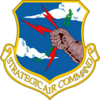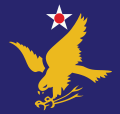| 95th Air Base Wing | |
|---|---|
 Maj. Gen. Jason Armagost, left, commander of 8th Air Force and Joint-Global Strike Operations Center, holds the guidon steady as Col. David Leaumont, 95th Wing commander, unfurls the 95th Wing guidon during the 95th Wing activation ceremony, March 28, 2025, at Offutt Air Force Base, Nebraska. The 95th Wing will provide civilian and military leaders with command-and-control capabilities over the nation’s strategic forces using a robust communications network. (U.S. Air Force photo by Charles Haymond) | |
| Active | 1942–1945, 1947–1949, 1952–1966, 1966–1976, 1994–2012, 2025-present |
| Country | |
| Branch | |
| Role | Base Support |
| Part of | A |
| Nickname(s) | "First B-17's over Berlin – 1944" (WW II) |
| Motto(s) | Justice with Victory |
| Decorations | Distinguished Unit Citation Air Force Outstanding Unit Award |
| Website | https://www.offutt.af.mil/Units/95th-Wing/ |
| Commanders | |
| Current commander | Col. David Leaumont |
| Notable commanders | Colonel Charles B. DeBellevue General John K. Gerhart General John Dale Ryan Lt Gen Gerald W. Johnson |
| Insignia | |
| 95th Air Base Wing emblem [note 1] [1] |  |
| 95th Bombardment Wing emblem [note 2] [2] |  |
| 95th Bombardment Group emblem [note 3] [3] |  |
| World War II Tail Marking [4] | Square B |
The 95th Air Base Wing is a tenant wing at Offutt Air Force Base that was activated on March 28, 2025. The mission of the 95th Wing is to operate a diverse set of Joint Total Force units and capabilities to assure worldwide survivable and enduring command and control to the President, Secretary of Defense, and Chairman throughout all hazards and the entirety of the threat spectrum to deter strategic attack on the homeland and enable uninterrupted execution of national security responsibilities. This unit also specializes in organizing, training, and equipping a dedicated team of 24/7 professionals to execute combatant commanders’ taskings on a global scale. Colonel David Leaumont is the current wing commander. CMSgt Michael Moore is the Wing Command Chief.
Contents
- History
- World War II
- Air Force Reserve
- Bombardment Operations at Biggs Air Force Base
- Tanker Operations at Goose Air Base
- Base Support at Edwards Air Force Base
- Global Strike Command Command and Control
- Lineage
- Assignments
- Components
- Stations
- Aircraft
- Awards and campaigns
- Notable members
- See also
- References
- Notes
- Bibliography
- External links
The wing was previously assigned to the Air Force Flight Test Center of Air Force Materiel Command at Edwards Air Force Base, California, where it was inactivated on 13 July 2012.
During World War II its predecessor, the 95th Bombardment Group, was a Boeing B-17 Flying Fortress unit in England, stationed at RAF Horham. It was the only Eighth Air Force group awarded three Distinguished Unit Citations, with the highest total claims of enemy aircraft destroyed of all Eighth Air Force Bomb Groups − 425 aircraft. It was also the first U.S. Army Air Forces group to bomb Berlin. [5] From 1947 to 1949 the 95th Bombardment Group served in the reserves. It was inactivated when Continental Air Command reorganized its reserve flying units under the wing base organization model.
During the Cold War, the Strategic Air Command (SAC) 95th Bombardment Wing performed strategic bombardment training with Convair B-36 Peacemaker and later Boeing B-52 Stratofortress bombers. It operated to support SAC's global commitments from April 1954 until SAC's phaseout of operations at Biggs Air Force Base, Texas in 1966. The wing was activated later that year as the 95th Strategic Wing at Goose Air Base, Canada to replace the 4082d Strategic Wing. At Goose, it supported forward deployed SAC tankers. It was inactivated in 1976 as the Air Force withdrew from Goose Air Base. [6]
In 1984, the 95th group and wing were consolidated into a single unit. The consolidated unit was redesignated the 95th Air Base Wing and was activated in 1994 as the host organization at Edwards, absorbing the mission, personnel and equipment of the inactivating 650th Air Base Wing.










